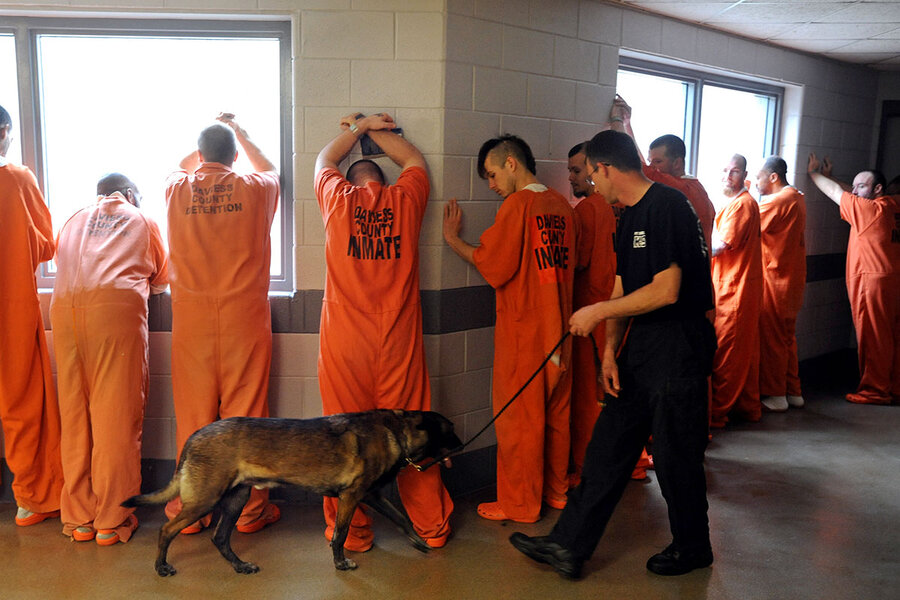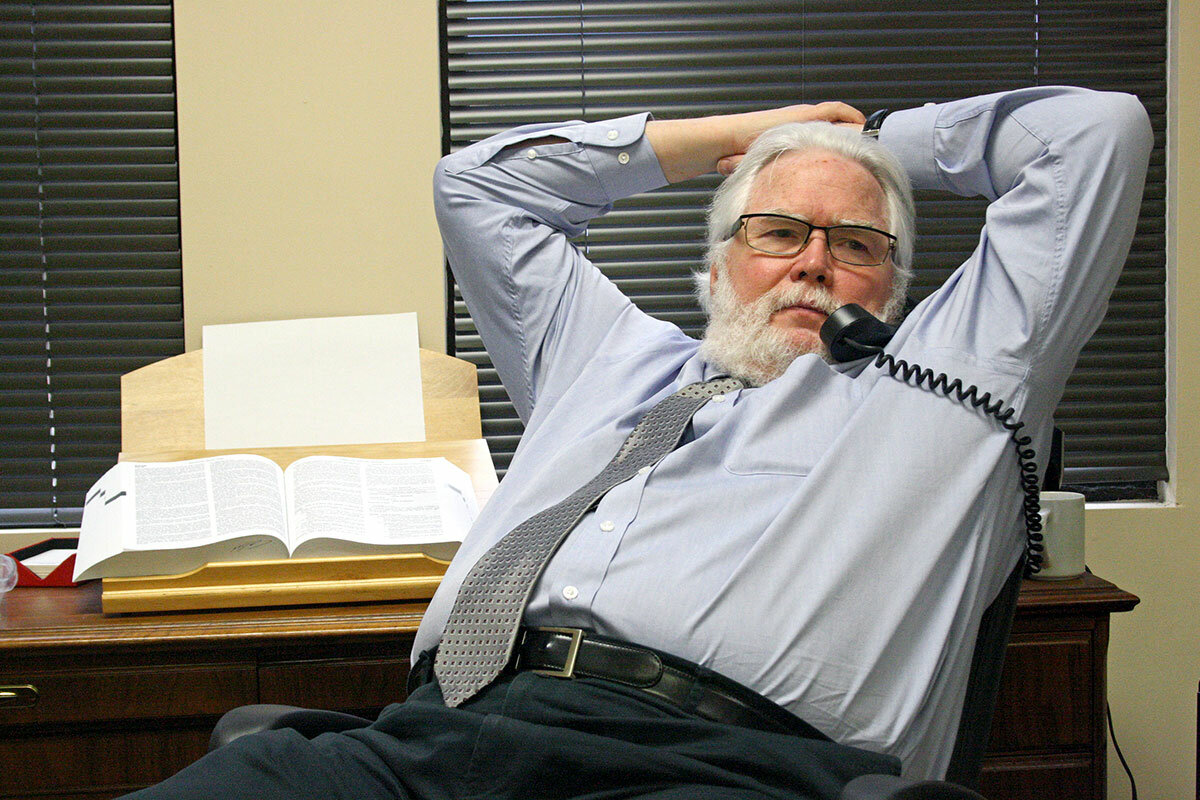In Kentucky, all sides agree on need for criminal justice reform. But how?
Loading...
| Frankfort and Hazard, Ky.
In 2009, both Tahiesha Howard and the state of Kentucky were looking for a fresh start.
Ms. Howard’s childhood was such a blur of dysfunction and addiction she says she couldn’t remember her first drink of alcohol. By her 30s, one judge labeled the mother a “menace to society.”
Kentucky, meanwhile, had become a poster child for ineffective and unsustainable mass incarceration – its prison system growing at quadruple the national average despite a consistently low crime rate.
Howard bought a one-way ticket to Louisville and began trying to conquer a drug addiction. Two years later, the Kentucky legislature passed a landmark law aimed at lowering the state’s prison population. For several years, things went well, for Howard and Kentucky. The inmate population dropped, while Howard stayed clean. She completed an in-patient drug treatment program, found a $16-an-hour job, and was saving to buy a house.
Then, as Howard describes it, “stuff happened” – and not just for her. She relapsed, losing her job and her home – eventually returning to the same treatment center she’d graduated from in 2011. Meanwhile, Kentucky struggled in the grip of the opioid crisis. Desperate to respond, the state legislature toughened sentences on heroin and fentanyl trafficking. For this and other reasons, experts in the state say, the prison population began to explode. Again.
Today, Howard is clean again. On an icy morning last month, she is sitting in the basement cafeteria in the state Capitol, her dyed-red dreadlocks and leopard-print vest standing out in a sea of suits. She, along with a half-dozen other recovering addicts sporting “Kentucky Smart on Crime” badges, are here to try and convince legislators to engineer a similar recovery for the state’s criminal justice system.
“I’m about to cry,” she says. “I never thought that I would be around people like this.”
“I’m excited to be able to tell my story,” she adds, “so that these people can understand what we as addicts deal with.”
After decades of tough-on-crime policies that swelled prison populations, the US justice system has been recalibrating. Since 2007, 35 states have reformed their sentencing and corrections policies, according to Pew, and states like Kentucky have been at the forefront.
The process has been slow and difficult in the Bluegrass State, however. The notion that more prisons don’t equal less crime now taking hold around the country is already firmly in place here. From prosecutors and public defenders to judges, legislators, and the conservative governor, nobody wants to build more prisons. But getting all those stakeholders to agree on what to do instead is proving just as challenging. As justice reforms unfold around the country, it is a challenge other states will surely face as well.
“There is certainly resistance from many stakeholders in the criminal justice community, and it’s understandable,” says John Tilley, the state justice secretary and a former Democratic state legislator who helped drive reform efforts here in 2011.
The state is on track to fill every single prison bed in the state by May 2019, despite a contingency plan to reopen three shuttered private prisons. If no significant changes are made, the prison population is projected to grow by 19 percent over the next decade at a cost of $600 million, according to a recent report from a working group (CJPAC) organized by Republican Gov. Matt Bevin.
“We’ve got to think of ways to mitigate that kind of damage,” adds Secretary Tilley. “We have to give the legislature policy options to begin down this path again.”
Early steps
When Ernie Lewis first began practicing law in Kentucky in the late 1970s, the state had about 3,000 people in prison. Over the next 30 years, as a defense attorney in trial court, he watched that number rise to about 22,000 people – despite the local crime rate staying relatively flat.
Until 2011, “we’d been almost totally averse to the reclassification of a crime downward,” adds Mr. Lewis, now the executive director for the National Association of Public Defense and the former head of the Department of Public Advocacy (DPA), Kentucky’s public defender agency.
The solution was House Bill 463, legislation authored by Tilley that aimed to lower the prison population by encouraging deferred prosecution and probation for some nonviolent offenses. But it was “much too timid,” says Lewis.
Crucially, experts say, many of the changes in the bill were left to the discretion of judges and prosecutors.
“That was seminal legislation for the time,” says Len Engel, director of policy and campaigns for the Crime and Justice Institute, which has partnered with Kentucky to research ways to improve its justice system. “The problem was it was not required.”
Prosecutors and judges, for example, were encouraged to use alternatives to a conviction for drug possession – such as diversion to a treatment program or a supervised release. However, between 2013 and 2016 drug possession convictions increased by 71 percent and prison admissions for drug possession increased by 102 percent, the CJPAC work group found.
The bill was not a failure, experts say. Kentucky’s prison population did decline for a few years, and it would be even higher today if the bill had not passed. But lessons have clearly been learned from the experience.
A reforms package state legislators are considering right now would afford much less discretion to prosecutors and judges. It would reclassify first degree drug possession from a felony to a misdemeanor, for example, and increase the threshold for a felony theft offense from $500 to $2,000. (Most states have raised their threshold to at least $1,000 to account for inflation.)
“We’re not trying to take away legitimate discretion,” says Republican state Rep. Jason Nemes, a co-sponsor of that bill, House Bill 396. “But when you’re talking about a drug possessor, not a robber or someone who committed a violent offense … there’s no [need for] discretion there. They just need treatment.”
If not prison, where?
“Most [cases] seemed to start in a bar,” says Will Collins, describing his years as a state prosecutor in the 1990s. “None of them ever start in a bar anymore.”
Mr. Collins now works as a public defender in Hazard, in impoverished eastern Kentucky, and most of his clients are charged with low-level drug possession or theft, usually to support their addiction.
“Poverty has been the immutable constant of Appalachia,” he says – and for generations addiction has been the balm.
What keeps changing – at a pace the criminal justice system always seems to lag behind – is the substances people are addicted to. In the 1990s, it was alcohol, then it was prescription painkillers. Now meth and heroin are emerging.
“We have poor people who were perhaps raised by people who were themselves soothing their anguish with drugs or alcohol,” he says. “The kinds of substances people are using [now], they’re just much more devastating than they once were.”
“Prison, you know, doesn’t stymie this,” he adds. “A five-year prison sentence or a 20-year prison sentence, the difference between that doesn’t, I think, impact the behavior of folks in that business or under that addiction.”
The prosecutors he works with have become more reasonable on bonds for his clients, and some judges are more open to ordering treatment instead of a prison sentence, he says.
In Paintsville, a small town of 4,000 people in eastern Kentucky, the local detention center is at 200 percent capacity. Roughly two-thirds of that population are people serving out their sentences for Class D drug possessions, says Kevin Holbrook, a local district judge who was a member of the governor’s CJPAC work group. Kentucky is one of a few states that pays local county jails to hold certain nonviolent offenders after a conviction, in addition to pretrial defendants unable to post bail, and so another reform being considered would restrict the use of monetary bail to certain high-risk defendants.
Judge Holbrook supports the idea, but he understands why “some judges have issues with their discretion being taken away” in that manner.
“If they’re [found to be] low- or moderate-risk, judges are concerned about releasing that person, especially if they’re an addict,” he adds, saying that the concern is if they don't receive treatment, they might hurt themselves – or someone else.
“All prosecutors and all judges have to be worried about public safety,” says Thomas Wine, the Commonwealth’s Attorney for Jefferson County, which includes all of Louisville.
And that concern for public safety means that some prosecutors want to know there are enough treatment facilities to handle all the low-level drug offenders that HB396 would divert from prison.
“Prosecutors [need to be] comfortable they’re going to get treatment, so the community is safe, and [the person] is safe, getting treatment and not out on the street,” adds Mr. Wine, “but that requires money upfront.”
His experience with previous reforms has made David Tapp, a judge in Kentucky’s 28th Judicial Circuit, south of Lexington, more cautious.
“If there is a rush to do something just to say we did something, I’m afraid we’re going to be in the same situation that the legislation in 2011 was intended to rectify but did not do so,” he says.
“We [should] slow down a little bit, perhaps look at refining some of the legislation, and be better prepared [to pass it in the next legislative session] in 2019,” he adds.
There is some skepticism over the validity of these concerns, however, not least from Van Ingram, executive director of Kentucky’s Office of Drug Control Policy, which manages the state’s drug treatment infrastructure. While he admits that 'no state' has enough of that infrastructure, Kentucky 'is getting better all the time.' "
“I don’t know when you pick a day when you say, ‘Now we’re there’ ” and have enough treatment facilities, he says.
And some reform advocates are concerned that, in an intensely political justice system – legislators, judges, prosecutors, and county jailers are all elected – more tough-on-crime policies may be difficult to resist.
“It has to be a factor,” says Tilley of the number of elected officials in the justice system. “When you’re accountable to an electorate and you have constituents it’s difficult,” he adds. “The safer route is often to lock somebody up.”
Take a bill Kentucky lawmakers passed last year. In an effort to fight the opioid epidemic, House Bill 333 increased penalties for the trafficking of “any amount” of heroin and fentanyl. The legislation eliminated a feature of the 2011 reforms that distinguished “between low-level addict dealers and high-level traffickers,” the CJPAC report said, calculating it will be responsible for approximately 40 percent of the state’s projected inmate growth over the next decade.
This session, the legislature has authorized $71 million in emergency funding to reopen three private prisons. The state Senate also removed from a bill – primarily aimed at improving a prison system that incarcerates more women than any other state bar Oklahoma – provisions to increase the felony theft threshold from $500 to $1,000 for some crimes, and to allow pretrial administrative release for certain misdemeanor defendants.
'It’s never-ending'
Kentucky is facing a significant time and inmate population crunch, however. Prison admissions for low-level drug possession charges increased by 102 percent here between 2012 and 2016. If nothing is done before this legislative session ends in mid-April, “the circumstances of the crisis are not going to be any better,” says Engel, from the Criminal Justice Institute, “and the politics of what needs to get done aren’t going to be any better.”
“You have lives behind all these decisions as well,” he adds. “Women who have trauma driving their decisions, who aren’t locked up now, will be locked up then.”
Some of the people who accounted for that 102 percent admissions increase are the women who joined Howard in Frankfort last month – all invited here by the American Civil Liberties Union of Kentucky to tell legislators how treatment, not long prison sentences, has changed their lives.
As they tour the Capitol building, Sabrina Bindner is the one telling jokes, the one organizing group photos, the one telling others to rub the toe of an Abraham Lincoln statue for good luck. She grew up in a stable, middle-class family, she played softball in high school. Touring the capitol rotunda, she looks like a stable, middle-class Kentuckian.
But in the decade or so between losing her best friend in a high school car accident and being court-ordered to the Healing Place, she became addicted to heroin, had two children, had them taken away, spent two years homeless, and accumulated 26 Class D felonies.
“All the cops knew me,” she says. “I really didn’t care what people thought of me anymore, because they couldn’t think worse of me than I already thought of myself.”
“The most beautiful thing I had was the love for my daughter and my son at that time, so I figured that if that love couldn’t keep me from messing up then I wasn’t really worthy of anything,” she adds. “If my judge didn’t make the decision to send me to treatment, I would have went to prison and I wouldn’t have changed nothing about myself.”
Treatment “instills in you those small things that society has lost, that love, just to generate positivity, to smile in every interaction with every human being you meet,” she continues. “That’s possible for other people too if they were just given the opportunity.”
In her photo with the Lincoln statue, Howard hugs it. While she agrees that drug treatment needs to be more accessible in the state, she tells every legislator she meets why she would like Class D felonies to be reclassified as misdemeanors.
“I could pursue college, I could get a masters degree … but I can’t do anything with it: I have felonies. I can’t even live in a decent neighborhood, even if I can afford it,” she says. “I’m stuck in a rut, and I’m not a part of that rut [anymore] and it’s scary for me.”
“I paid for my mistakes; I’ve been drug through the mud for my mistakes; I live my mistakes every day,” she adds. “Where do I get to see the light?”
As challenging as this new reform effort has been in Kentucky, there are signs that it could ultimately be successful.
For one, it is a deeply personal effort, from Howard to Tilley and everyone in between.
Tilley’s 2011 bill led to the closure of three private prisons in the state. A year later, the state ended three decades of private prison use in 2012 amid allegations ranging from riots to sexual abuse of female inmates.
For another, law enforcement is urging legislators to do something. The Kentucky State Police currently has an underfunded Internet Crime Unit, Nemes says, and can’t afford to buy new cruisers. Alex Payne, the agency’s deputy commissioner, testified in support of HB396 last month. Wayne Turner – a police chief in northern Kentucky and state’s police chief of the year in 2017 – wrote in a January op-ed that “while this [tough-on-crime] sentiment, which has largely been our criminal justice approach for the last 35 years, may sound good and tough it is, in fact, expensive and ineffective.”
The gains could be erased over the coming years, however. If no significant reforms are implemented this session or the next, the state will be required to spend $71 million to reopen two more private prisons to handle the increased prison population.
“I don’t want anyone to get the misperception that this is a ‘want to.’ This is a ‘has to,’ ” says Tilley. “I have begrudgingly embraced the reality that we have no place to put the inmates being sent to us.”
For Nemes, the criminal justice system has been no help to his sister – who has struggled with addiction for more than a decade – and her three sons.
“The system as it is does not work. It’s terrible for families,” he says. “We have to identify problems that we need to solve.”
Legislators in Kentucky have been trying to do that for years, of course, and Nemes doesn’t think they’re getting closer to the finish line. He doesn’t think there is a finish line.
“The criminal justice system, because it’s such a big part of every state, [reforms] will never end,” he adds. “It’s a never-ending thing you have to look at to make sure you’re doing the right thing.”








